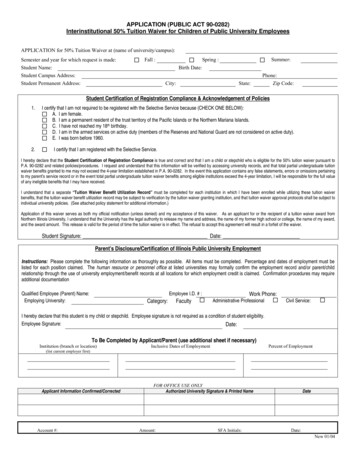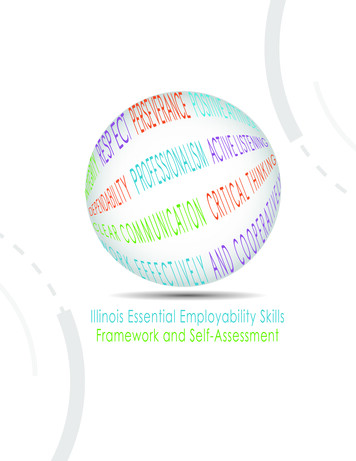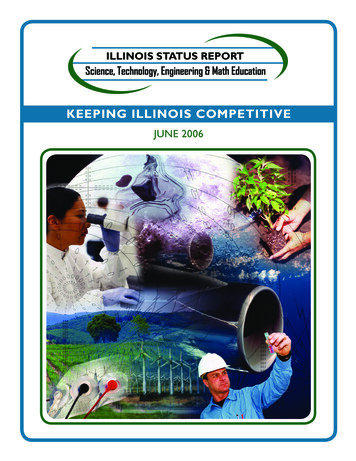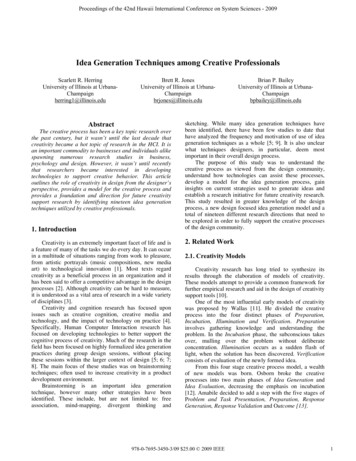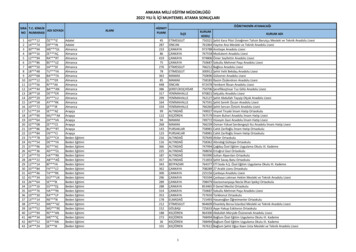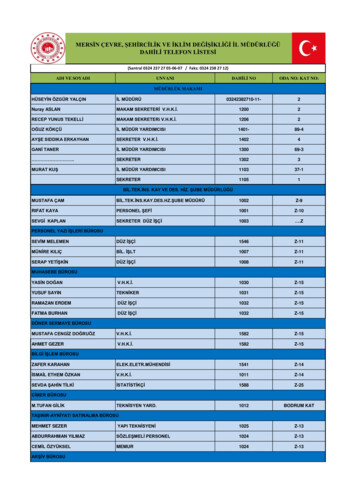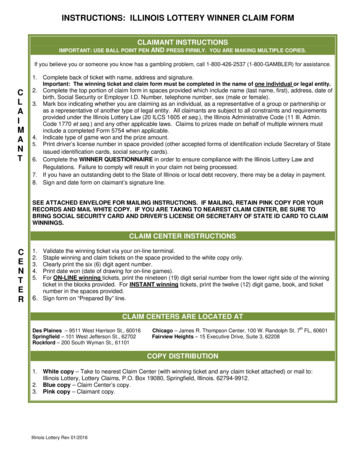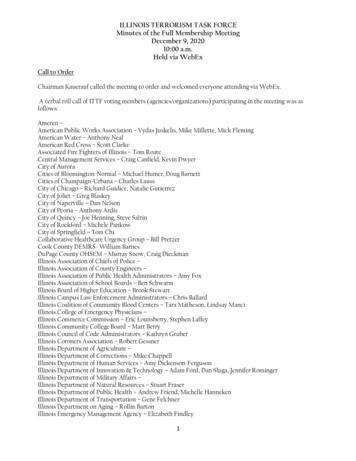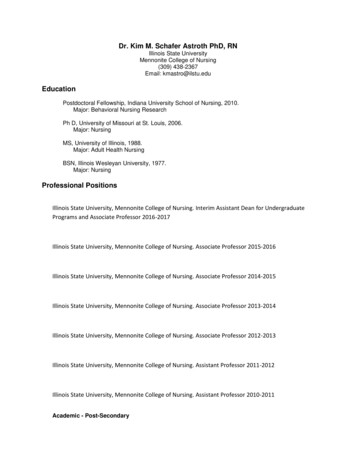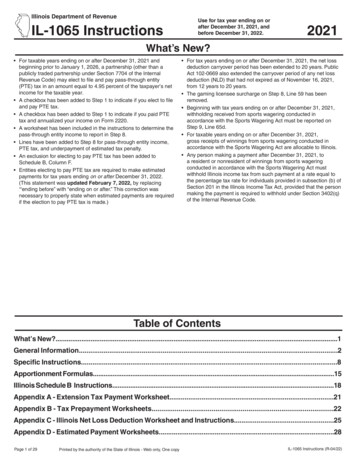
Transcription
Illinois Department of RevenueUse for tax year ending on orafter December 31, 2021, andbefore December 31, 2022.IL-1065 Instructions 2021What’s New? For taxable years ending on or after December 31, 2021 andbeginning prior to January 1, 2026, a partnership (other than apublicly traded partnership under Section 7704 of the InternalRevenue Code) may elect to file and pay pass-through entity(PTE) tax in an amount equal to 4.95 percent of the taxpayer’s netincome for the taxable year. A checkbox has been added to Step 1 to indicate if you elect to fileand pay PTE tax. A checkbox has been added to Step 1 to indicate if you paid PTEtax and annualized your income on Form 2220. A worksheet has been included in the instructions to determine thepass-through entity income to report in Step 8. Lines have been added to Step 8 for pass-through entity income,PTE tax, and underpayment of estimated tax penalty. An exclusion for electing to pay PTE tax has been added toSchedule B, Column F. Entities electing to pay PTE tax are required to make estimatedpayments for tax years ending on or after December 31, 2022.(This statement was updated February 7, 2022, by replacing‘“ending before” with “ending on or after.” This correction wasnecessary to properly state when estimated payments are requiredif the election to pay PTE tax is made.) For tax years ending on or after December 31, 2021, the net lossdeduction carryover period has been extended to 20 years. PublicAct 102-0669 also extended the carryover period of any net lossdeduction (NLD) that had not expired as of November 16, 2021,from 12 years to 20 years. The gaming licensee surcharge on Step 8, Line 59 has beenremoved. Beginning with tax years ending on or after December 31, 2021,withholding received from sports wagering conducted inaccordance with the Sports Wagering Act must be reported onStep 9, Line 65d. For taxable years ending on or after December 31, 2021,gross receipts of winnings from sports wagering conducted inaccordance with the Sports Wagering Act are allocable to Illinois. Any person making a payment after December 31, 2021, toa resident or nonresident of winnings from sports wageringconducted in accordance with the Sports Wagering Act mustwithhold Illinois income tax from such payment at a rate equal tothe percentage tax rate for individuals provided in subsection (b) ofSection 201 in the Illinois Income Tax Act, provided that the personmaking the payment is required to withhold under Section 3402(q)of the Internal Revenue Code.Table of ContentsWhat’s New?.1General Information.2Specific Instructions.8Apportionment Formulas.15Illinois Schedule B Instructions.18Appendix A - Extension Tax Payment Worksheet.21Appendix B - Tax Prepayment Worksheets.22Appendix C - Illinois Net Loss Deduction Worksheet and Instructions.25Appendix D - Estimated Payment Worksheets.28Page 1 of 29Printed by the authority of the State of Illinois - Web only, One copyIL-1065 Instructions (R-04/22)
General InformationWho must file Form IL-1065?When should I file?You must file Form IL-1065, Partnership Replacement Tax Return,if you are a partnership (see “Definitions to help you complete yourForm IL-1065”) and you have base income or loss as defined underthe Illinois Income Tax Act (IITA) allocable to Illinois.In general, Form IL-1065 is due on or before the 15th day of the 4thmonth following the close of the tax year.If you are a partnership organized for the sole purpose of playing theIllinois State Lottery, you are not required to file a Form IL-1065.A person transacting an insurance business organized under aLloyd’s plan of operation may file a Form IL-1065 on behalf of all itsunderwriters, including corporations and residents. You must refer to86 Ill. Adm. Code Section 100.5130, for specific instructions on howto properly complete Form IL-1065 and determine what you need toattach to your return.All underwriters who are members of an insurance business organizedunder a Lloyd’s plan of operation may be included on Form IL-1065.No credit is allowed to any underwriter for its share of tax paid onForm IL-1065.What forms must I use?In general, you must obtain and use forms prescribed by the IllinoisDepartment of Revenue (IDOR). Separate statements not on formsprovided or approved by IDOR will not be accepted and you willbe asked for appropriate documentation. Failure to comply withthis requirement may result in failure to file penalties, a delayin the processing of your return, or a delay in the generationof any overpayment. Additionally, failure to submit appropriatedocumentation when requested may result in a referral to our AuditBureau for compliance action.Partnerships must complete Form IL-1065. Do not send a computerprintout with line numbers and dollar amounts attached to a blank copy ofthe return. Computer generated printouts are not acceptable, even if theyare in the same format as IDOR’s forms. Computer generated forms froman IDOR-approved software developer are acceptable.If you are a member of a unitary business group, you may not file acombined return, but you may have special filing requirements. See theinstructions for Illinois Schedule UB and “What if I am a member of aunitary group?” in the general instructions below for information about yourfiling requirements.Form IL-1065 (R-12/21) is for tax year ending on orafter December 31, 2021, and before December 31, 2022. Fortax years ending on or after December 31, 2020, and beforeDecember 31, 2021, use the 2020 form. Using the wrong form willdelay the processing of your return.How do I register my business?If you are required to file Form IL-1065, you should register withIDOR. You may register online with MyTax Illinois, our free online account managementprogram for taxpayers; by completing Form REG-1, Illinois Business RegistrationApplication, and mailing it to the address on the form; or by visiting a regional office.Visit our website at tax.illinois.gov for more information.Registering with the IDOR prior to filing your return ensures thatyour tax returns are accurately processed.Your identification numbers as an Illinois business taxpayer areyour federal employer identification number (FEIN) and your Illinoisaccount number.Page 2 of 29If you are operating as a business organized under the Lloyd’s planof operation, your due date is the same as your federal return duedate.Automatic six-month extension — We grant you an automaticsix-month extension of time to file your partnership tax return. Theautomatic extension of time to file is granted whether or not yourequest it. You are not required to file a form in order to obtain thisautomatic extension. If you expect tax to be due, you must pay anytentative tax due, by the original due date of the return, in order toavoid interest and penalty on tax not paid by that date. To pay any taxdue by the original due date of your return: visit tax.illinois.gov, for information about ACH credit, pay using mytax.illinois.gov, or mail Form IL-1065-V, Payment Voucher for PartnershipReplacement Tax, using the address on the form.If an unpaid liability is disclosed when you file your return, then youmay owe penalty and interest charges in addition to the tax. See the“What are the penalties and interest?” section below. An extensionof time to file your Form IL-1065 is not an extension of time forpayment of Illinois tax.If you are operating as a business organized under the Lloyd’s planof operation, the length of your Illinois automatic extension of time tofile is the same as your federal extension.Additional extensions beyond the automatic extension period —We will grant an additional extension only if an extension is grantedby the Internal Revenue Service (IRS) beyond the date of the Illinoisautomatic extension. Your additional Illinois extension will be for thelength of time approved by the IRS. You must attach a copy of theapproved federal extension to your Form IL-1065.When should I pay?Payment of tax — You must pay your Illinois Replacement Tax andpass-through withholding reported on behalf of your members or PTEtax in full on or before the original due date of the return. Failure topay the tax due on or before the original due date of the return mayresult in penalty and interest. This payment date applies even thoughan automatic extension for filing your return has been granted. Allpayments must be made using Form IL-1065-V, Payment Voucher forPartnership Replacement Tax.Extension Payments - If you expect tax to be due, you must payany tentative tax due by the original due date of the return usingForm IL-1065-V. See Appendix A for more information.Estimated tax payments — Partnerships who elect to pay PTEtax and reasonably expect their total tax liability to exceed 500 arerequired to make estimated tax payments using Form IL-1065-V. Allother partnerships are not required to make estimated tax payments.See Appendix D for more information.Voluntary Prepayments - You may make voluntary prepaymentsof your own tax liability as well as make pass-through withholdingprepayments on behalf of your partners using Form IL-1065-V. SeeAppendix B for more information.We encourage you to make your payments electronically usingMyTax Illinois or Modernized E-File (MeF) systems, or you mayuse Form EFT-1, Authorization Agreement for Certain ElectronicPayments, to set up an ACH credit or phone debit transaction. Theseoptions can be found on our website at tax.illinois.gov. If you makeyour payments using MyTax Illinois, MeF, or EFT, do not mail us yourIL-1065 Instructions (R-04/22)
IL-1065-V forms. You must use one of our electronic payment optionsif IDOR has notified you that you are required to make paymentselectronically.We will apply each payment to the earliest due date until that liabilityis paid, unless you provide specific instructions to apply it to anotherperiod. You may also be assessed a bad check penalty if yourremittance is not honored by your financial institution.Who should sign the return?Your Form IL-1065 must be signed by a partner or any other officerduly authorized to sign the return. In the case of a bankruptcy, areceiver, trustee, or assignee must sign any return required to befiled on behalf of the partnership. The signature verifies by writtendeclaration (and under penalties of perjury) that the signing individualhas personally examined the return and the return is true, correct,and complete. The fact that an individual’s name is signed to a returnis prima facie evidence that the individual is authorized to sign thereturn on behalf of the partnership.If you are operating as a business organized under the Lloyd’s plan ofoperation, an officer of that plan must sign Form IL-1065.Any person paid to prepare the return (other than a regularemployee of the taxpayer, such as a clerk, secretary, or bookkeeper)must provide a signature, date the return, enter the preparer taxidentification number (PTIN) issued to them by the Internal RevenueService, and provide their firm’s name, address, and phone number.If your return is not signed, any overpayment of tax isconsidered forfeited if, after notice and demand for signature, you failto provide a signature within three years from the date your returnwas filed.What are the penalties and interest?Penalties — You will owe a late-filing penalty if you do not file a processable return by theextended due date; a late-payment penalty if you do not pay the tax you owe by theoriginal due date of the return; a late-payment penalty for underpayment of estimated tax ifyou were required to make estimated tax payments and failed todo so, or failed to pay the required amount by the payment duedate; a bad check penalty if your remittance is not honored by yourfinancial institution; and a cost of collection fee if you do not pay the amount you owewithin 30 days of the date printed on your bill.Interest — Interest is calculated on tax from the day after the originaldue date of your return through the date you pay the tax.We will bill you for penalties and interest. For more information aboutpenalties and interest, see Publication 103, Penalties and Interest forIllinois Taxes.What if I am discontinuing my business?Liquidation or withdrawal from Illinois — If you are a partnershipthat is liquidated or withdraws either voluntarily or involuntarily fromIllinois during any tax year, you are still required to file tax returns.Also, we will pursue the assessment and collection of any taxes owedby you or your partners.Sales or transfers — If you are a partnership that, outside the usualcourse of business, sells or transfers the major part of any one or more of the stock of goods which you are in the business of selling, the furniture or fixtures of your business,you or the purchaser must complete and send us Form CBS-1,Notice of Sale, Purchase, or Transfer of Business Assets, no laterthan 10 business days prior to the date the sale takes place. Sendthis form, along with copies of the sales contract and financingagreement, to:ILLINOIS DEPARTMENT OF REVENUEBULK SALES UNITPO BOX 19035SPRINGFIELD IL 62794-9035orREV.BulkSales@illinois.govWhat if I need to correct or change my return?Do not file another Form IL-1065 with “amended” figures to changeyour originally filed Form IL-1065. If you need to correct or changeyour return after it has been filed, you must file Form IL-1065-X,Amended Partnership Replacement Tax Return. Returns filed beforethe extended due date of the return are treated as your originalreturn for all purposes. For more information, see Form IL-1065-Xinstructions.You should file Form IL-1065-X only after you have filed a processableIllinois Income Tax return. You must file a separate Form IL-1065-X foreach tax year you wish to change.State changes only — File Form IL-1065-X promptly if you discoveran error on your Illinois return that does not relate to an error on yourfederal return but rather was caused by a mistake in transferring information from your federal return to yourIllinois return; failing to report or misreporting to Illinois an item that has no effect onyour federal return; or a mistake in another state’s tax return that affects the computation ofyour Illinois tax liability.If you are claiming an overpayment, Form IL-1065-X must be filed withinthree years after the extended due date or the date the return was filed,or within one year after the tax giving rise to the overpayment was paid,whichever is latest.Federal changes only — File Form IL-1065-X if you have filed anamended federal return or if you have been notified by the IRS that theyhave made changes to your return. This includes any change in yourfederal income tax liability, any tax credit, or the computation of yourfederal taxable income as reported for federal income tax purposes, ifthe change affects any item entering into the computation of net income,net loss, or any credit for any year under the IITA. You must file FormIL-1065-X no later than 120 days after the federal changes have beenagreed to or finally determined to avoid a late-payment penalty.If your federal change decreases the tax due to Illinois and youare entitled to a refund or credit carryforward, you must fileForm IL-1065-X within two years plus 120 days of federal finalization.Attach a copy of federal finalization or proof of acceptance from theIRS along with a copy of your amended federal form, if applicable, toyour Form IL-1065-X. Examples of federal finalization include a copyof one or more of the following items: your audit report from the IRS and your federal record of account verifying your ordinary businessincome.What records must I keep?You must maintain books and records to substantiate any informationreported on your Form IL-1065. Your books and records must beavailable for inspection by our authorized agents and employees. the machinery and equipment of your business, or the real property of your business,Page 3 of 29IL-1065 Instructions (R-04/22)
Do the IDOR and the IRS exchange incometax information?The IRS and IDOR exchange income tax information for the purposeof verifying the accuracy of information reported on federal andIllinois tax returns. All amounts you report on Form IL-1065 aresubject to verification and audit.Should I round?You must round the dollar amounts on Form IL-1065 andaccompanying schedules to whole-dollar amounts. To do this, youshould drop any amount less than 50 cents and increase any amountof 50 cents or more to the next higher dollar.What if I have an Illinois net loss deduction(NLD)?An Illinois net loss deduction (NLD) can be used to reduce the baseincome allocable to Illinois only if the loss year return has been filedand to the extent the loss was not used to offset income from anyother tax year. S corporations and partnerships, including any thatare members of a unitary group, trusts, and non-unitary corporationsshould use the Illinois Net Loss Deduction Worksheet in Appendix Cto determine any NLD.To determine your “Illinois net loss” start with federal taxable incomeand apply all addition and subtraction modifications and all allocationand apportionment provisions.In order to have any available NLD applied to your return, you mustclaim the deduction on Step 7, Line 48. See specific instructions forStep 7, Line 48.If you have an Illinois net loss for this tax year, you must file FormIL-1065 reporting the loss in order to carry the loss forward toanother year.If corrections have been made to the loss amount (e.g., federal auditor amended return), you must report the corrected amount when youfile.Ensure you have filed returns (i.e., Form IL-1120, FormIL-1120-ST, Form IL-1041, or Form IL-1065) for all periods in whichyou were required to file an Illinois return. Unfiled returns may resultin disallowed losses, processing delays, and further correspondencefrom IDOR.If you need more information about Illinois NLDs see Appendix Cor the 86 Ill. Adm. Code Sections 100.2050 and 100.2300 through100.2330, available on our website at tax.illinois.gov.What are the limitations of the Illinois NLD?For tax years ending on or after December 31, 2021, Illinois netlosses cannot be carried back and can only be carried forward for 20tax years.For tax years ending on or after December 31, 2003, and beforeDecember 31, 2021, Illinois net losses can no longer be carriedback, and can only be carried forward for 12 years. However,the carryover period of any net loss that has not expired as ofNovember 16, 2021, shall be extended from 12 years to 20 years.For tax years ending on or after December 31, 1999, and beforeDecember 31, 2003, all Illinois net losses must be carried back twoyears (unless an election to only carry forward is made) then forward20 years. The election to carry a loss forward only was made bychecking the appropriate box on the original or amended loss-yearreturn, whichever showed the loss first. Once the election was madeto forgo the Illinois carryback provision, the election was irrevocable.Illinois net losses in tax years ending before December 31, 1999,are allowed as a carryback or carryforward deduction only in thePage 4 of 29manner allowed under Internal Revenue Code (IRC) Section 172,including, for example, the 10-year carryback allowed to banks forbad debt losses.The following are the carryback and carryforward years generallyallowed for Illinois net losses in tax years ending beforeDecember 31, 1999. Illinois net losses in tax years beginning after August 5, 1997, and ending before December 31, 1999,must be carried back two years, then forward 20 years. on or before August 5, 1997, must be carried back three years,then forward 15 years.For tax years ending on or after December 31, 1996, andbefore December 31, 2003, you may have made the election to forgoany of the previously mentioned Illinois NLD carryback periods bychecking the appropriate box on your loss year return. This electionmust have been made by the extended due date of your return andonce made was irrevocable for that tax year.In addition, the special carryover periods in IRC Section 172, as ineffect for a particular tax year, would apply to losses incurred in thatyear. For example, a “specified liability loss” incurred in 1998 may becarried back 10 years under IRC Section 172(b)(1)(c).Also, no limitations under IRC Section 382 or the separate returnlimitation year provisions of the federal consolidated returnregulations apply to any NLD carryover.What is the standard exemption?The standard exemption is 1,000 multiplied by a fraction in whichthe numerator is your base income allocable to Illinois and thedenominator is your total base income. If you have a change in yourtax year end, and the result is a tax period of less than 12 months,the standard exemption is prorated based on the number of days inthe short tax year. However, if this is your first or final return, you areallowed to use the full-year standard exemption even if it is a shorttax year. If you need further information, see IITA Section 401(b).For tax years beginning on or after January 1, 2017, thestandard exemption may not be claimed if your unmodified baseincome is 250,000 or more. See Specific Instructions for moreinformation.What attachments do I need?When filing your return there are certain types of income itemsand subtraction modifications that require the attachment ofIllinois or federal forms and schedules. Breakdowns, statements,and other documentation may also be required. Instructions forthese attachments appear throughout the specific instructions forcompleting your return.If you are operating as a business organized under the Lloyd’s plan ofoperation, refer to 86 Ill. Adm. Code Section 100.5130, to determinewhat you need to attach to your Form IL-1065.All Illinois forms and schedules include an “IL AttachmentNo.” in the upper right corner of the form. Required attachmentsshould be ordered numerically behind the tax return, as indicated bythe IL Attachment No. Failure to attach forms and schedules in theproper order may result in processing delays.Required copies of documentation from your federal return or othersources should be attached behind the completed Illinois return.You must attach a copy of your federal Form 1065, Pages 1through 5, to your Illinois return if you are required to file federally.Schedule B, Partners’ or Shareholders’ Information, must becompleted and attached to all Form IL-1065 filings.You are required to attach any Schedule(s) K-1-P, Partner’s orShareholder’s Share of Income, Deductions, Credits, and Recapture,and Schedule(s) K-1-T, Beneficiary’s Share of Income andDeductions, you receive. Attach Schedule(s) K-1-P and K-1-T youIL-1065 Instructions (R-04/22)
received which lists your name and FEIN in Step 2 of ScheduleK-1-P or K-1-T. Do not attach copies of Schedule(s) K-1-P youissued and which lists your name and FEIN in Step 1 of ScheduleK-1-P.When filing your Form IL-1065, include only forms andschedules required to support your return. Send correspondenceseparately to:ILLINOIS DEPARTMENT OF REVENUETAXPAYER CORRESPONDENCEPO BOX 19044SPRINGFIELD IL 62794-9044Definitions to help you complete your Form IL-1065All references to “income” include losses.Base income means federal ordinary income plus separately stateditems, modified by additions and subtractions as shown in Steps2 through 5 of Form IL-1065. See specific instructions for Steps 2through 5.Business income means all income (other than compensation) thatmay be apportioned by formula among the states in which you aredoing business without violating the Constitution of the United States.All income of a partnership is business income unless it is clearlyattributable to only one state and is earned or received throughactivities totally unrelated to any business you are conducting in morethan one state. Business income is net of all deductions attributableto that income.Commercial domicile means the principal place from which yourtrade or business is directed or managed.Nonbusiness income means all income other than business incomeor compensation. For more information about the different types ofnonbusiness income, see the instructions for Illinois Schedule NB,Nonbusiness Income.A partnership is an entity that is treated as a partnership for federalincome tax purposes. A partnership that elects an IRC, Section 761exclusion from the federal partnership provisions is also excluded forpurposes of the IITA.PTE tax is an amount equal to 4.95% of the taxpayer’s calculatednet income for the taxable year paid by a partnership (other thana publicly traded partnership under Section 7704 of the InternalRevenue Code) or subchapter S corporation who elects to pay thetax for taxable years ending on or after December 31, 2021, andbeginning prior to January 1, 2026.PTE tax credit is the distributive share of the credit allowed as aresult of a partnership or S corporation having elected to pay thePTE tax.PTE tax credit is reported to your partners on the Schedule K-1-P and reported to IDOR on your Form IL-1065 and Illinois Schedule B.A nonresident individual partner of a partnership for a taxable yearin which the election to pay PTE tax was made shall not be requiredto file an income tax return under the IITA for such taxable year ifthe only source of net income of the individual (or the individualand the individual’s spouse in the case of a joint return) is from anentity making the PTE election and the credit allowed to the partnerequals or exceeds the individual’s liability for the tax imposed undersubsections (a) and (b) of Section 201 of the IITA for the taxable year.Pass-through withholding is the amount required to be reportedand paid by the pass-through entity, who does not elect to payPTE tax, on behalf of its nonresident partners, shareholders, andbeneficiaries who have not submitted Form IL-1000-E, Certificate of Exemptionfor Pass-through Withholding, to the pass-through entity, and who receive business and nonbusiness income from thepass-through entity.Pass-through withholding is reported to your partners on the Schedule K-1-P you send tothem, reported to IDOR on your Form IL-1065 and Illinois Schedule B,and paid with your return or voluntarily prepaid with Form IL-1065-V. an individual who is present in Illinois for other than a temporary ortransitory purpose;If any of your partners are pass-through entities themselves,they are required to report and pay pass-through withholdingon behalf of their own nonresident partners, shareholders, orbeneficiaries on the income you passed through. Your partners mayclaim a credit on their Illinois Income Tax return for pass-throughwithholding you reported and paid on their behalf. an individual who is absent from Illinois for a temporary ortransitory purpose but who is domiciled in Illinois; Pass-through withholding you owe on behalf of yourmembers is a payment of pass-through withholding you makeon behalf of your nonresident partners who have not submittedForm IL-1000-E to you. This amount will be reported on FormIL-1065, Line 59. Pass-through withholding reported to you is a credit forpass-through withholding you receive on Schedules K-1-P andK-1-T as a partner, shareholder, or beneficiary of a pass-throughentity. This amount will be reported on Form IL-1065, Line 65c.Partner includes a person treated as a partner for federal income taxpurposes.A resident partner meansPartnerships can both make and receive pass-through withholding. the estate of a decedent who at his or her death was domiciled inIllinois; a trust created by a will of a decedent who at his or her death wasdomiciled in Illinois; or an irrevocable trust if the grantor was domiciled in Illinois at thetime the trust became irrevocable. For purposes of this definition,a trust is irrevocable to the extent that the grantor is not treatedas the owner of the trust under IRC Sections 671 through 678.For a more detailed explanation of “domicile” and “resident,” seethe General Instructions for Form IL-1040, Individual Income TaxReturn.Nonresident partner means a partner who is not a resident ofIllinois, as defined previously.A pass-through entity is any entity treated as a partnership,subchapter S corporation, or trust for federal income tax purposes.Pass-through entity income is the income that any partnership,subchapter S corporation, or trust passes through to its partners,shareholders, or beneficiaries.Page 5 of 29If you are a nonresident and the pass-through withholding reported toyou satisfies your Illinois Income Tax liability, you are not required tofile an Illinois Income Tax return. If you had Illinois income from othersources and the pass-through withholding made on your behalf doesnot cover your liability, you must file a return to report the tax on all ofyour Illinois income and claim a credit for pass-through withholdingmade on your behalf.All residents and pass-through entities must file their own annualIllinois Income Tax ret
A person transacting an insurance business organized under a Lloyd's plan of operation may file a Form IL-1065 on behalf of all its underwriters, including corporations and residents. You must refer to 86 Ill. Adm. Code Section 100.5130, for specific instructions on how to properly complete Form IL-1065 and determine what you need to
